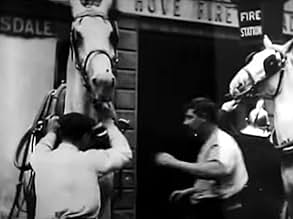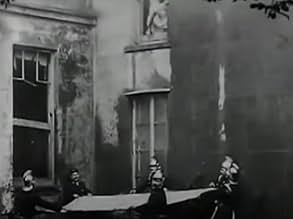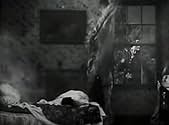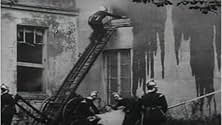Ajouter une intrigue dans votre langueFirefighters ring for help, and here comes the ladder cart; they hitch a horse to it. A second horse-drawn truck joins the first, and they head down the street to a house fire. Inside a man ... Tout lireFirefighters ring for help, and here comes the ladder cart; they hitch a horse to it. A second horse-drawn truck joins the first, and they head down the street to a house fire. Inside a man sleeps, he awakes amidst flames and throws himself back on the bed. In comes a firefighter... Tout lireFirefighters ring for help, and here comes the ladder cart; they hitch a horse to it. A second horse-drawn truck joins the first, and they head down the street to a house fire. Inside a man sleeps, he awakes amidst flames and throws himself back on the bed. In comes a firefighter, hosing down the blaze. He carries out the victim, down a ladder to safety. Other firefig... Tout lire
- Réalisation
Avis à la une
While the basic idea was fairly simple, the film-makers were resourceful in including shots of several aspects of the situation. It's worth paying attention to the details, both in the reactions of the persons in the house, and in the settings. Not least among the interesting aspects of this movie is the chance to have a detailed look at the fire-fighting equipment of the era.
A lot of action is packed into a few minutes, and while the way that it is pieced together may be just a bit rough in places, the editing is very commendable for a time when there was little experience to go by. All in all, this is among the better-made narratives of its time.
The story is very simple: the typical rescue of a family from a burning building premise. The film uses 5 scenes to tell it: the first scene is when the cop discovers the burning building, the second the firemen leave to go to the rescue, the third a shot of the racing firemen, the fourth scene is the rescue of the man, and the continuation of the events continue in the last scene, a shot of the outside of the house.
Also, note that firemen rescue scenes were very popular in cinema's first years. In 1896 the Lumiere brothers filmed a street scene of firemen racing to the rescue (A Fire Run), and even before that was an early Edison short depicting a rescue scene ("Fire Rescue Scene"). Filmmakers really must've found firemen to be an exciting subject for early dramas. While the story really isn't involved enough, for 1901 it was exceptional and the film is one that would actually be interesting to see today.
This film stands as one of the first of the recent films that are partly drama but also quite documentary like in their delivery. It shows the reporting of a fire, the response, the fighting and the rescue of those in the house. On one level it is interesting to see this as it happened 100 years ago but on another level it is a well put together film that has some good action, including ladder climbing and an one-storey jump to safety. It is a bit limited by being on just one side of a house but still, it is interesting and technically well put together.
The plot's simple enough - a house goes on fire and the firemen come to quench it and rescue the inhabitants. The fascination lies in the details. The way the fire's smoke swirls and obscures the view, a subversive element that undermines cinema's clarity, it's claim to record things - the firemen are not just extinguishing a fire, or restoring order, the primacy of property and family, but retrieving cinema's purpose, which here betrays interesting tensions.
The preparations of the firemen, laborious because the engine is still horse-drawn, and the animals are a little stroppy - the proud tumescence of a very phallic wheeled ladder is startling, suggesting that hazards to the social order can only be solved by the Men that run it. The gallop through gorgeous turn of the 20th century Brighton streets, eerily old (to us) and empty, the horses speeding towards the camera before veering to avoid it. The fire itself - the not very patriarchal hysteria of the father who just cries like a big girl without doing anything practical, particularly surprising when we discover he has a wife and child.
After he is rescued he waits in agoinising panic for someone: when his child is brought out and restored to him, the feminisation or maternalisation (sic?) of the father is unusual for the period. We assume his wife is dead, as he wanders off the screen, removing his child from the bourgeois home-haven that suddenly became so treacherous. When we see the wife rescued to her family's general indifference, it's shocking.
the breach in the film's form from the documentary-like preparations and rescue, and the flagrant artifice of the interior settings and the wild overacting results in an interesting tension that filmmakers like Murnau, Welles and Godard would later explore, and which echoes the film's ideological tensions, the vulnerability of the bourgeois myth.
Rounding off this brilliant film is the closing scene, a long shot of the smoking house with the firemen below it. There appears to be a huge peeling of the wall's paint, suggesting the house's age, which is visually startling, a visual violence matching the destructive fire. We discover that this is actually water from the hose - so that the saviours within the narrative create a breach in the film's form.
Le saviez-vous
- ConnexionsFeatured in Loin de Hollywood - L'art européen du cinéma muet (1995)
Meilleurs choix
Détails
- Durée5 minutes
- Mixage
- Rapport de forme
- 1.33 : 1

















